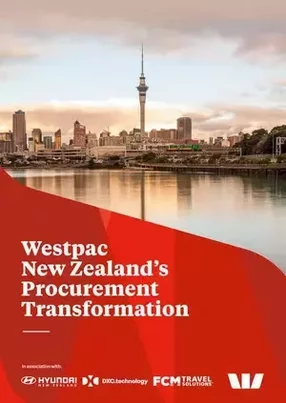Westpac New Zealand: CPO Rob Halsall drives a digital supply chain transformation
It would be a mistake to think of Westpac in the same way as one thinks of the big global corporate banks, even though it is one of the ‘big four’ in Australia. For a start it doesn’t even sound like a bank, its portmanteau name, adopted in 1982 when it merged with a number of Australian banks, signifying the western pacific region rather than the finance sector. Westpac has been in New Zealand ever since it was founded as the Bank of New South Wales in 1861, and today Westpac New Zealand is the government banker as well as serving businesses throughout the country and more than 1.3mn customers.
Talking to Rob Halsall, the bank’s Chief Procurement Officer (CPO), one quickly begins to appreciate why it is different. For a start, it is very closely aligned to the values that make New Zealand an outstanding place to live. That’s illustrated by three issues it places right at the front of its agenda – promoting electrification in transport, tailoring its services for people with dementia and providing equal opportunities to women, especially in leadership roles.
The first of these is a passion of Westpac NZ CEO David McLean, who drives an electric car himself, and has joined a group of large corporations in committing the bank to a 30% electric fleet by the end of next year. Halsall himself is on the board of Drive Electric. “Transitioning to EVs is more complex than just ordering the cars: you have to take the infrastructure, people’s habits and preferences as well as total cost. At the bank we’ve been working on the project for the last twelve months.”
Halsall is in his fifth year with the bank, and recently awarded Ernst & Young New Zealand Procurement Professional of the Year’ for 2018. A native of Belfast, he has over 20 years’ experience in procurement and supply chain management, 11 years of which were in manufacturing across telco, automotive and aerospace, with a further five years in tertiary before entering the financial services industry. Halsall joined the Westpac Group in Australia as Director of Commercial Services in 2014 and in 2016 he jumped at the chance to move to New Zealand when offered the role in Auckland. On his arrival in Auckland, he found a procurement culture that worked well, but needed to refocus on the basics which he thought necessary to support the bank through the next phase of its growth. “Before we could embark on full scale transformation, we had to get the basics right, and for me that meant looking at the core dimensions of our operating model and re-establish the purpose and value proposition of the function.”
His strategy for changing the operating model was formulated under ‘eight Ps’:
- People (capability maturity, learning & development roadmap, improved engagement);
- Product (what are our core products and services and do our stakeholders understand them?);
- Process (are the core processes effective and do business partners understand them?);
- Platforms (the right data, document and information management tools, source-to-manage, and simple task automation);
- Partners (the approach to internal business partner management and external supply partner management);
- Planning (collaborative cycles, to co-create on innovation, for example);
- Pace (the rate of change and the cadence, or rhythm at which the business can regularly and consistently deliver projects that effect change);
- Progress (measuring everything so that all processes can be evaluated, Voice of Customer, Voice of Supplier, Value Creation).
“These are the lenses I tend to use to examine our current state and where we need to be heading. When I joined the team there was room for improvement under all of these headings,” Halsall says. “Today, data is like oxygen to any business. From a Procurement specific perspective, we have moved over the last 18 months from a data poor, insight poor position to one where we are richer on the data side and have created more insights through the use of analytics.”
The science of procurement is all about data and making the right choices based on the insights that the data provides, he believes. The art is the narrative around the data and the change it suggests. “We focus heavily on both those areas. We built a repository of spend, contract and business unit data that we could interrogate and visualise using a Microsoft product that was available to us in-house.” The painstaking task of building a database and a data analytics structure has resulted in far better transparency across the supply base and the spending patterns of the bank. Not so much cost reduction, Halsall says, as cost management; enabling movement from the reactive to the proactive. “At the very least, we are now able to say that we know what we don’t know.”
The data analytics structure is complementary to Westpac’s new networked Purchase-to-Pay (P2P) platform. The Basware system was introduced in 2017 and has made a big difference. “Until then, the bank didn’t have a P2P system. It gives us a level of transactional data and insight that we didn’t have previously and it has also allowed us to create supplier payment efficiencies, something that is of the first importance to them.” Another direct benefit of implementation was to rationalise the bank’s supplier base by 40%, with a further consolidation planned by 2020, Halsall adds.
As a career procurement professional, Halsall naturally looks at ways to raise the profile of the team. “In my experience, it’s a question of overcoming any apathy that may exist towards procurement by demonstrating its value to stakeholders.” By rebranding the Procurement function to Commercial Services, he signalled his determination to move away from being viewed purely as a sourcing function to a trusted advisor to all the business units. “We have definitely increased our strategic role. The engagement at executive level is higher than it has ever been before. Collaboration with our key business partners on planning and identifying key projects is now embedded, where even a year ago it was minimal.”
Procurement is now accepted by the executive leadership as a contributing partner in commercial decision-making. It is also seen as being more digitally enabled with improved operating disciplines. His team works very closely with the Technology team.
Fortnightly meetings to define priorities and shared targets have been so successful that the same style of collaboration now takes place with the operations and marketing teams. “IT, analytics, artificial intelligence, simple task automation, IoT and cognitive technologies mean the workforce of the future will do things very differently,” Halsall says. “Speaking as a procurement professional, I will be very surprised if around 40% of the tasks we do today cannot be automated or completed by cognitive systems within the next five years.”
The profession will look different too. Halsall anticipates that relational, social and commercial skills, and the ability to think and act strategically, will take centre stage. “For me, procurement is about being a trusted advisor to the business: a commercial advisor delivering innovation and relationships for our market but also leveraging the technology so we can do our job faster and smarter.”
It’s a deep and ongoing change management process. Weekly 30-minute sprint sessions on relevant commercial and continuous improvement topics were introduced to leverage and transfer collective knowledge and create project delivery efficiencies. In practical terms, we have been able to understand who has experience in a particular subject area and we have created a knowledge hub within our team so everybody can benefit from that material and is key to the development of the team.
Halsall also engaged ArcBlue, a specialist procurement consultancy and training provider and CIPS partner, to complete a competency assessment resulting in the delivery of technical training aligned to professional development goals within the function. The team also worked on a Vendor Open Learning Tribe (VOLT), a concept designed in partnership with the internal Technology business unit leaders to accelerate innovation with supply partners.
Over three days, business units within the bank were invited to pitch challenges to key suppliers, who then came back with solutions. “VOLT was actively co-creating innovation, and it is amazing how quickly that can happen if you establish the correct forum,” Halsall comments. “We learned a lot from this experience and have plans to build on this in the future”.
Supply chain transformation means having a greater partnership with fewer suppliers and doing it in a more collaborative way. Internally, implementing a new intranet and the P2P system, rebranding the function and kick-starting innovation in just one year, is something Halsall says would have taken three in any other organisation he has experienced. “We have introduced rapid transformation into the team, and that was necessary because we had to build agility and effectiveness into our operating model. We measure employee engagement using a global benchmark, and over the last year this has risen by 23% and is now above the global benchmark we use within the group.”
Work in progress for his team is to continue to deliver commercial outcomes for the business, and deepen collaborative working with internal partners and external supply partners. Halsall intends to continue working on analytics using Microsoft Dynamics and Power BI data visualisation, exploring machine learning options and leveraging the LinkedIn ‘XRM’ functionality to improve the bank’s approach to supplier relationship management. Then, finally, there’s sustainability. This is definitely a supply chain matter, says Halsall, from realising the NZ Chief Executive’s vision to convert 30% of the fleet to electric by 2019, to Westpac’s global responsible sourcing initiative, which aims to ensure that all suppliers meet required ethical standards. “The sustainability agenda is huge. We’ve been leading the way in sustainability leadership and we remain a leading sustainable bank globally. Our aim is to build on what we’ve achieved and to continue meeting our sustainability targets.”
For Westpac NZ, a progressive procurement and sustainability objective, and passion of Halsall’s, is creating more opportunity to recognise and build on our supplier inclusion and diversity including Maori, as the country’s indigenous population. “We are working with partners to establish how we can develop a supplier database that would include Maori suppliers, categorised in a way that will allow all procurement practitioners within NZ to understand their services. New Zealand doesn’t have an equivalent to Australia’s Reconciliation Action Plan targets, or Supply Nation. However, we believe that by working with other public and private partners in New Zealand, we have the opportunity to create a body that will help supplier diversity, including Maori suppliers in New Zealand.
“We held a social procurement symposium in July 2017, with 200 local community leaders, procurement leaders and suppliers. We invited CPOs from telecommunications, banks, insurance, government and other community partners including Auckland Tourism (ATEED), Air New Zealand, Auckland Council, and also the chief executive of Supply Nation, to help share interest and knowledge in this area. The entire catering and product placement was provided by diverse local Maori and Pasifika suppliers.”




